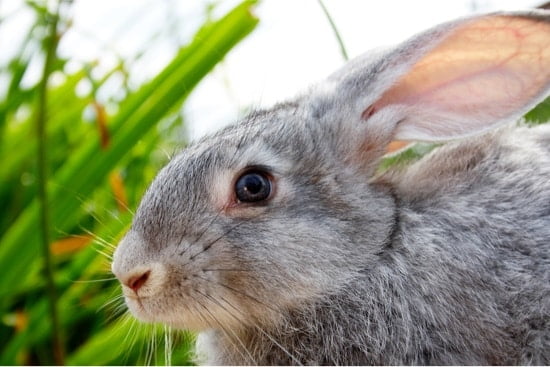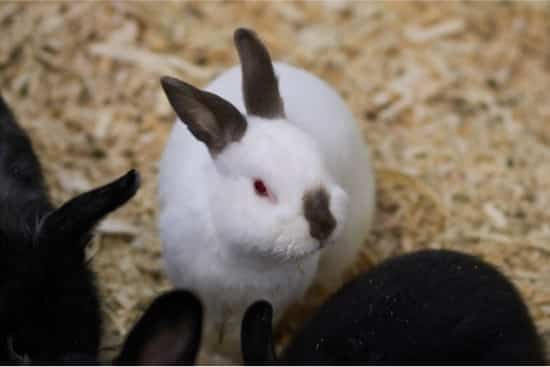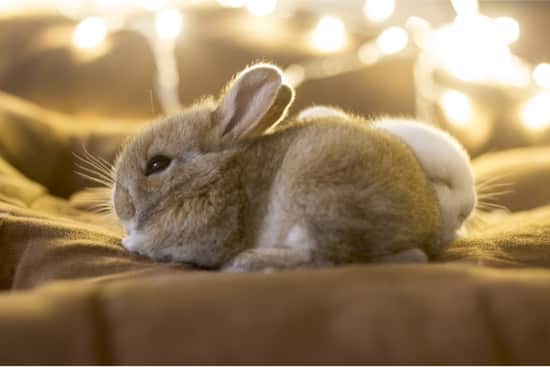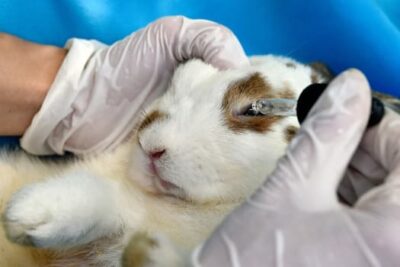Rabbits are naturally clean animals. They take their grooming regime seriously, which is why ‘eye boogers’ in rabbits are always so noticeable. These stains around your rabbit’s eyes are stubborn, and cannot be cleaned up by their own paws. Leaky tear ducts usually cause them to occur.
The discharge may be due to a temporary irritation to the eye or a blocked tear duct (dacryocystitis). Conjunctivitis (pink eye) is a common reason for weeping. Glaucoma is rare in rabbits, but very serious. Rabbits also get abscesses around their eyes.
The problem may also be physical. Some rabbits experience genetic defects around their eyelids, causing excess tears. Overgrown teeth can also pierce tear ducts. Eye boogers always have an explanation. If they persist beyond 24 hours, the problem is chronic and must be resolved.
Why Does My Rabbit Have Eye Discharge?
Your rabbit’s crusty eyes could be a temporary issue that will right itself. Their eyes may be watering due to a one-off irritation. For example, your pet may have poked themselves in the eye with hay.
If the discharge becomes constant, they may have an illness. Usually, it’s something that can be cleared up with a course of antibiotics. Rabbits can be prone to an array of eye infections.
When you spot eye boogers on your rabbit’s fur, clean them up. The longer they stick around, the worse they’ll become. If the problem does not recur, you have nothing to worry about.
If your rabbit has recurrent eye discharge, you need to look into things more closely. When inspecting your rabbit’s eye, any stickiness is a bad sign. This suggests that pus is leaking from the eye, and antibiotics will be required to clear up the infection.
Foreign Object Causing Eye Irritation
Always ensure that your rabbit doesn’t have something in their eye at the onset of discharge. They may have poked themselves with food or a toy.
As long as the rabbit did not scratch their cornea, this will quickly correct itself. The discharge will cease once the irritation passes. This should not take more than 24 hours.
Perhaps your rabbit has fur, or an eyelash, trapped in their eye. This will appear as a white ‘cloud’ that floats in your rabbit’s cornea. Dwarf rabbits, which have larger, rounder eyes, are particularly prone to this issue.

Eventually, bunnies will remove the hair themselves while washing their face. It’s best to leave your pet to do this. Attempting to remove the hair with tweezers places them at risk.
Just observe your rabbit for a day or two. You’ll notice that things return to normal. If this is not the case, an underlying sickness is the cause, and treatment will be required.
Conjunctivitis
Conjunctivitis is known as Pink Eye or Weepy Eye. The disease is a result of inflammation behind the eye. In rabbits, it often stems from their nictitating membrane. This is the rabbits ‘third eyelid.’
According to Wagwalking, around 30% of bunnies will develop this condition at least once. In addition to weeping eyes and eye boogers, impacted rabbits continuously rub their eyes.
It can affect rabbits for several reasons. It can be a reaction to an irritant, allergy, or bacterial infection. In most cases, it’s caused by proximity to a fellow sufferer.
Conjunctivitis is contagious in humans, and it spreads just as quickly among rabbits. If you have multiple bunnies and one is struck down, prepare to treat all your pets. Sharing water bottles and toys will pass on the condition.
Be mindful of your health, too. Conjunctivitis can be passed on from rabbits to humans. Always wear gloves while handling a rabbit with this condition.
A vet will prescribe an ointment or eye drops, which will relieve your rabbit’s symptoms.
Despite the simplicity of treating conjunctivitis, you should still seek medical assistance immediately. It can be uncomfortable for rabbits to live with. This will make them stressed, and put them off their food. Rabbits are not large enough to starve themselves.
Conjunctivitis can always reoccur. This is especially likely if a hutch mate catches it from your rabbit, or even you. Treatment deals with the problem as a one-off; it does not immunize humans or rabbits.
While your rabbit is undergoing treatment, clean their hutch thoroughly. Change their hay and bedding, and wash and disinfect all toys and cage bars. Remove any traces of bacteria.
Physical Defects of the Eye
Rabbits with shorter faces are prone to blockages of their tear ducts. Their tear ducts (nasolacrimal canals) are particularly narrow. This leads to blockages, and continuous production of tears.
A vet may agree to open the nasolacrimal canals surgically. This will only be attempted if the rabbit’s quality of life is compromised, though. Regular treatment with lubricating eye drops is preferred.
Abnormalities surrounding the eyelids are more likely to be treated surgically. If a rabbit’s eyelids turn inward or outward, or grow at abnormal angles, they must be corrected.
There are also impact injuries. If your rabbit scratches their eye, they may develop an ulcer. This will be painful, and need to be treated with eye drops
Viral Infections (Snuffles)
If your rabbit has snuffles, they’ll also have a runny nose and sneeze a lot. Snuffles in rabbits is comparable to the ‘flu in humans. The prognosis of this condition is also similar to the ‘flu.
If your rabbit is healthy, they can recover from the illness naturally. They need plenty of rest. In elderly rabbits, or those with existing medical conditions, snuffles can be more dangerous.

Treatment for snuffles will involve a course of antibiotics. It’s at your discretion as to whether you consider this necessary for your bunny.
Just be aware that snuffles are highly contagious among rabbits. If one of your pets catches the disease, any hutch mates will likely follow suit before long.
Glaucoma in Rabbits
Glaucoma is a disease in which a rabbit’s eye generates too much fluid. It’s serious, but rare.
The main issue with glaucoma is that the symptoms are minor at first. Some rabbits do not even show any discomfort. Eye boogers can be a warning sign, though.
Glaucoma results from excessive fluid behind your rabbit’s eye. This fluid needs to go somewhere. It is often released as excessive tear production. This will turn crusty.
Glaucoma must be treated quickly. If left too long, it can lead to irreversible blindness.
A vet will prescribe eye drops. Follow-up appointments will also be necessary to check your rabbit’s progress. The medication may need to be changed, or enhanced.
Glaucoma treatment is a lifelong commitment. The disease is never entirely eradicated. You’ll need to clean your rabbit’s eyes regularly and check for signs of reinfection.
If your rabbit has a bonded friend, this will help. Rabbits often groom each other. This means that your bunny will receive constant attention, reducing the risk of glaucoma reoccurrence.
Dacryocystitis in Rabbits
Dacryocystitis occurs when a rabbits tear duct becomes infected with bacteria. It’s similar to an abscess. Dacryocystitis does not often involve swelling, though.
The key symptom, other than a thick discharge that creates eye boogers, is a red eye. Your rabbit will also be in clear physical discomfort.
The most common cause of dacryocystitis is overgrown teeth. A rabbit’s teeth never stop growing. They need to be filed and managed by gnawing. Regularly eating hay helps, as will chew toys.
If left untreated, the tooth root will continue to grow. This can eventually puncture the tear duct. Treatment for dacryocystitis is essential.
There are two steps to treating dacryocystitis. The disease itself must be managed using eye drops. These will flush the bacteria from your rabbit’s eye. This is only solving half the problem. Your rabbit’s teeth will continue to grow, and the dacryocystitis will reoccur.
Your vet will place your rabbit under sedation. They will then trim their teeth down to size using a tool. Your rabbit will not feel a thing when they wake up, and their issue will be resolved.
This remains a temporary fix, though. Your rabbit’s teeth will grow again, so you may need to consider lifestyle changes. Check their diet, and ensure it’s high in fiber. The more a rabbit chews, the healthier their teeth will be.

Abscesses in Rabbit Eyes
Abscesses affect rabbits with puncture wounds around their eye, allowing bacteria to flourish. Like dacryocystitis, elongated teeth can often cause this. Biting can also cause abscesses, so be careful if your bunny fights another rabbit.
When an abscess takes hold, it fills the area with pus. This leads to swelling. In this instance, a rabbit may struggle to open their eyes. This pus can leak as discharge, creating foul-smelling eye boogers.
The first warning sign of an abscess is a bump. This will often be sensitive to the touch. If you notice this, alongside discharge, see a professional. Abscesses are painful, and potentially dangerous.
Even an experienced and rabbit-savvy vet will dread treating an abscess in a rabbit’s eye. The location of an abscess around a rabbit’s delicate eye compounds the challenge.
The vet will surgically remove the abscess. The area will then be flushed, and antibiotics prescribed to prevent the abscess from returning. Rabbits are prone to recurring abscesses, though.
If the abscess is too hard to access and cannot be removed, it will be opened. The same treatment will then follow. The abscess is highly likely to return in this situation.
How to Clean a Rabbit’s Eyes
Rabbits clean their own eyes while cleaning their face by licking their paws and rubbing their fur.
A rabbit will not be able to clear up eye boogers by themselves. The staining caused by constantly running tear ducts can be stubborn. Chronic watery eyes are also a symptom of illness.
Clean up your rabbit’s eyes as soon as you notice discharge by using the following technique:
- Keep your rabbit calm and sedate. It may be advisable to ask for help. If somebody else holds your bunny, you’ll complete the clean much faster.
- Run a soft cloth under some warm water.
- Hold the wet cloth onto the stained area. Don’t apply pressure, and don’t dab. Just let the water soak into the fur. This will soften the eye booger.
- Wait a few seconds, then wipe. This should remove the staining. If it doesn’t, repeat the process.
- If necessary, gently wash your rabbit’s face. Only use a bunny-centric shampoo for this. Rabbits have delicate skin pH. Products designed for humans, dogs and cats can hurt them.
Once you have finished cleaning your pet’s eyes, leave them be for 24 hours.
How Often Should I Clean My Rabbit’s Eyes?
Give your rabbit’s eyes a once-over every time you give them a general clean. This shouldn’t be any more than once a week.
Most rabbits can easily tolerate less frequent cleaning. They are naturally clean animals. They’ll take care of their eye health as part of their grooming routine.
You should clean a rabbit’s eyes every time you see eye discharge. If your bunny’s eyes keep watering, there will be a reason. Cleaning is resolving a symptom, not finding a cure.
The occasional eye booger is par for the course with rabbits. Chronic, constantly weeping eyes, though, is not. If your bunny’s eye boogers reappear as quickly as you clean them up, see a vet.

